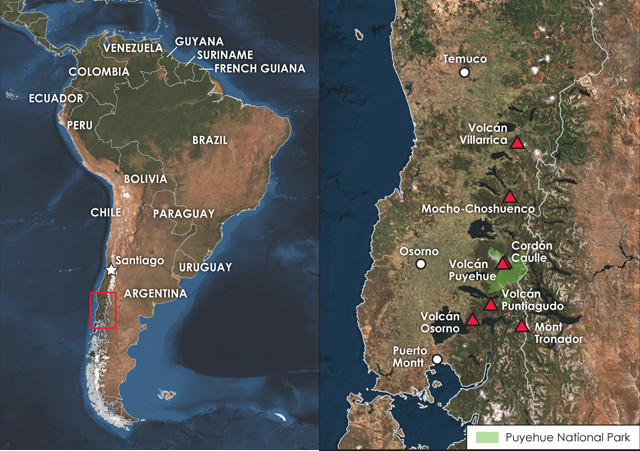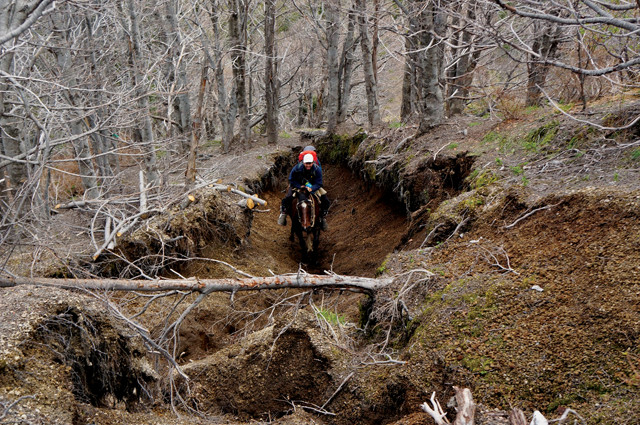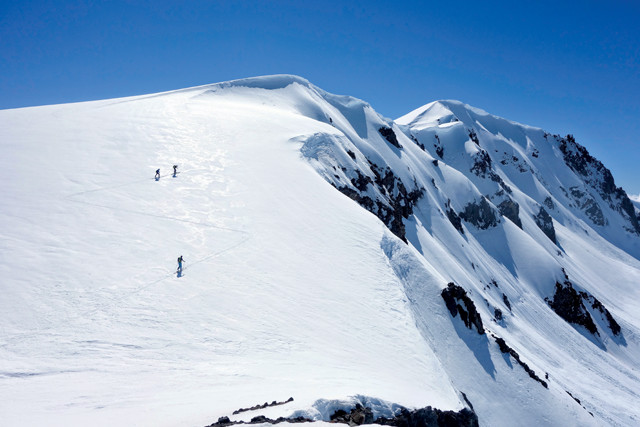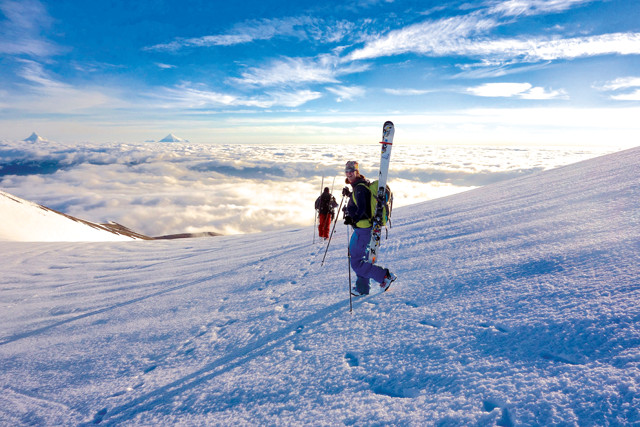
by Karin Kirk Monday, March 2, 2015

Stratovolcanoes in Southern Chile offer extreme skiing, otherworldly views and unforgettable adventure. Credit: Karin Kirk.
“OK, everybody,“our guide said. “Just calm down.” His voice had an edge to it, but the words were calming. “I know this is intense. But everyone take a deep breath. We’re OK. We’re almost there.” I obeyed, quieted my mind, and hoped that we were indeed almost there. He continued, with a return to his usual lightheartedness, “Remember, you wanted an adventure, and now you’re getting one.”
Here we were, a ragtag group of four skiers and one guide, on horseback, in a thick Andean forest. We were on our way to climb and ski a remote volcano, a plan that sounded absolutely alluring from the safety of my laptop as trip proposals bounced around our emails last summer. As a skier, geologist and traveler, I enjoy making ambitious plans. But this particular idea had taken hold of me like none other. Normally, my trips are less oriented toward a single objective, and I am usually content with a well-rounded adventure. Not so with this trip. I wanted the big prize: to ski inside a volcanic caldera. This temptation kept me awake at night for weeks leading up to the trip. What would the caldera look like? Would there be volcanic hazards? Would the skiing be fun? But, most frequently, my mind wandered to the long list of variables that could prevent our success: bad weather, broken gear, injury, illness or even a dysfunctional team dynamic in a group of unvetted travel partners.

Chile's Southern Volcanic Zone is dotted with active volcanoes. Volcán Puyehue and neighboring Cordón Caulle form one of the most geothermally active areas in Chile. Credit: Kathleen Cantner, AGI.
The caldera in question belongs to Volcán Puyehue, a stratovolcano in Puyehue National Park in southern Chile’s Lake District. The Southern Volcanic Zone of the Andes boasts dozens of iconic volcanoes, many of them active. No matter where you travel in this region, stunning peaks command the horizon. Some, like Volcán Osorno and Volcán Villarrica, are near-perfect snow-capped cones, shimmering high above glacial lakes and lush forests. Others, like Mount Tronador and Volcán Puntiagudo, have complex topography resulting from a variety of eruptive styles combined with glacial erosion. And others still have endured explosive eruptions and collapsed on themselves, forming calderas of varying shapes and sizes.
The Puyehue caldera, as I had learned before the trip, is about 1.5 kilometers across. The floor is permanently covered in ice. The steep walls are about 200 meters high and hold snow well into the Southern Hemisphere spring. It makes for an attractive skiing destination, despite the area’s pesky habit of erupting every now and then. Puyehue is part of a larger volcanic complex, and along with its neighbor Cordón Caulle, it forms one of the most geothermally active areas in Chile. The 300,000-year-long eruptive history of these mountains features plenty of ongoing activity. While Puyehue has been quiet lately, Cordón Caulle has erupted eight times in the last 100 years, most recently in 2011–2012 when an explosive, Plinian-style eruption smothered downwind towns in ash and suspended air travel as far away as Australia.
But that eruption ceased way back in 2012, I reasoned with myself before the trip. The area had had more than two years in which to cool down. What could possibly go wrong?

The skiers and their mounts left the green pastures at the base of the mountain and navigated a deeply rutted trail to reach the base camp above the forest. Credit: Karin Kirk.
The idea of riding horses up to base camp had sounded quaint in an email months earlier. And now, the novelty factor was running high as we snapped selfies in our brightly colored skiwear, ready to ride our sturdy mounts off into a beautiful spring morning. We felt energetic and optimistic after enduring more than our fair share of curveballs in the trip thus far, including diverted flights and missed connections due to fog at the Santiago airport and an equipment problem that preempted a much-needed day of practice.
The Chilean arrieros had loaded up the pack horses with our skis and gear. We were set to go; spirits were high. “ut as we soon learned, grueling terrain lay between us and the rustic refugio that would be our base camp for four days. The steep surface of mud, volcanic ash and pumice fragments was slippery and unreliable. Consequently, the trail had become so deeply entrenched that you could run your hands along the walls of the ruts as the horses worked their way up. That is, if you weren’t holding firmly onto your horse with both hands.
“hen the going got tough, the horses dripped with sweat while the cowboys urged the animals along with shouts of “Vamos!” It seemed like one of those moments that something could go very wrong. Suddenly, a flash of blue and yellow arced through the air. A fellow skier, Alex, had been lofted from his horse before landing in a pile on the muddy ground.
“Alex, are you OK?” shouted our guide, Donny, whose normal demeanor was one of good humor and persistent optimism. But now, with Alex shaken up and in a heap on the flank of the volcano, the seriousness in Donny’s voice spoke volumes. A tense moment followed. Yes, Alex was OK; thankfully, he landed just fine. His horse was OK too. Donny issued calming reassurance. Alex climbed back on board and we proceeded.

The horses navigated a deeply rutted trail. Credit: Donny Roth.
Injury had been just one of my concerns. Another was the thought of descending, quickly, into a closed caldera. I felt somewhat comfortable assessing basic volcanic hazards, like evidence of seismic activity, rapidly melting snow and ice, or geothermal activity. But what about the potential for skiing down into an invisible cloud of suffocating volcanic gases inside the caldera? Moreover, when on the outer flanks of a volcano, one can always descend away from trouble (or, try to, anyway). Once we were in the caldera, however, there would be no chance of a quick exit.
To allay my fears prior to the trip, or at least further research them, I had emailed the U.S. Geological Survey’s (USGS) Cascades Volcano Observatory. I reasoned that the Cascades share an analogous tectonic setting with the Andes and that the researchers at the observatory deal with similar hazards in the Cascades. Scientist-in-charge John Ewert provided a helpful response to what must have been an unusual question: How dangerous is it to ski down into a volcanic caldera?
Before digesting the specifics of his reply, I scanned it for tone. Does he think we are crazy? But there was no suggestion that we reconsider our plan. Ewert instead offered the precise advice I was looking for. First, he noted symptoms of hazardous gases that we ought to watch for, such as the smell of burning matches (indicative of sulfur dioxide) or rotten eggs (hydrogen sulfide). He told us to be alert for increases or changes in gas odors, or steaming, particularly in the absence of shifting wind and changing weather conditions that might otherwise affect the gases. He warned of small, enclosed spaces such as tree wells or ice caves that could harbor carbon dioxide, and he provided a link to the USGS web page on volcanic ash and gas hazards.
Ewert went on to note that a fledgling volcano monitoring program is underway in Chile, with a series of monitoring stations recently installed on peaks that pose a likely hazard. This was reassuring information, even though I opted not to dwell on his closing statement: “Of course, none of this information will help anyone caught near a suddenly active volcanic vent that is showering the local area with large rocks, and helmets only go so far.”

Steam rises from a lava flow, still cooling from the 2011–2012 eruption of the Puyehue-Cordón Caulle volcanic complex. Credit: Karin Kirk.
The sight of snow-clad Volcán Puyehue was especially welcome as we emerged from the steep forest onto rolling grass foothills. We had made it this far; one more obstacle could be checked off our list.
The next day, another major variable also worked in our favor — the weather. We awoke to a calm, clear day, packed gear for a variety of contingencies and set out for the caldera. With skis on our feet, we all felt a whole lot better than on the previous day. To ascend, we affixed nylon plush “skins” — modern substitutes for the animal hides that were historically used — to the bottoms of our skis, which provided grip on the way up. Skinning, as it is called, is a slow, steady, calculated effort. But, done properly, it’s enjoyable in its own right.
About an hour into the climb, we spotted what at first we thought might be weather instruments. Upon closer inspection, we realized it was a volcano monitoring station — with solar panels, instruments inside locked metal boxes, radio antennas, and a telltale GPS unit mounted on the metal frame to monitor ground movement. An email and photo sent to Ewert after the trip confirmed this station was part of Chile’s volcano monitoring network and shares a similar design with those used by the USGS.

The walls of the caldera reveal layered ash and pyroclastic rocks from repeated eruptions. Credit: Karin Kirk.

The author and her ski group climbing up a shoulder on an outside flank of the caldera before their initial descent into the volcano. Credit: Yeuhi Abe.
As we continued our ascent, Puyehue showed no signs of suddenly transforming into an active volcano. There were only a few areas with a sulfurous odor, and the slopes held onto their snow cover consistently. From the outside, it looked and felt like any other mountain.
“You guys are awfully quiet back there,” Donny noted, after all four of us had fallen silent for the first time on the whole trip. Maybe it was the exertion, or our minds wandering to the upcoming skiing challenge. Personally, I was consumed with our proximity to the big goal. From the next ridgeline, Donny called down, “Karin, you’re going to pee your pants when you see this.”
We had not reached the caldera quite yet; rather, on an adjacent flank of the mountain lay a rugged lava flow, stark black against the snow. But something was amiss: the lava flow looked a little blurry. Despite having erupted in 2011, it was still steaming. Donny’s prediction almost proved right; I am excited by active geology and this was indeed an exciting prelude to the main event.
Just a few strides later we were rewarded with the view I had been imagining for months — the caldera. To be honest, though, at that moment, I was assessing the skiing more than the volcanic geomorphology. Before me lay the most impressive, unusual skiing I’d ever seen. All the walls of the caldera were steep and technical, while the floor was dead flat. The south-facing walls were rimmed with imposing cornices, blocking practical access. The north-facing walls were generally snow-free. (In the Southern Hemisphere, the southern aspects are shaded and cooler while the north-facing slopes are sunny and warm — the opposite of the Northern Hemisphere.) Thus, the east and west rims would be our targets for skiing. They looked inviting, and, at the same time, intimidating.

Taking skiing beyond the commercial ski area can offer greater challenges, but also immeasurable rewards. Credit: Yeuhi Abe.
We planned our entrance into the caldera: a few test turns, on an easy shoulder, followed by a committing move over the crater’s edge and down into a 45-degree chute. Donny went first. He looked tiny and inconsequential as he paused on the rim, and then disappeared.
I was next. I dropped into the run and got my first taste of the skiing. Entering the caldera, the ground dropped away before I even had a chance to assess where I was. Loose snow cascaded down the slope along with me.
There is a beautiful moment in skiing, when you release yourself from the safety of the slope behind you and commit to whatever lies ahead. In this case, that unknown territory was like nothing I’d ever pointed my skis toward: a daunting combination of rock and snow, the flat caldera floor below, and an incredible, untamed expanse in front of me. There was no need for hesitation or uncertainty. After everything it took to reach this point, the skiing was the easy part. We’d made it. This was exactly the moment for which I had come.
We spent an adrenaline-filled afternoon and early evening climbing and skiing in the caldera, soaking in the otherworldly experience and trying to etch it permanently into our memories. After one last climb out, we headed home, awash in the high-elevation sunset as we skied our way triumphantly down to camp, each of us pausing for one more look back over our shoulders. Did we really just do that?
© 2008-2021. All rights reserved. Any copying, redistribution or retransmission of any of the contents of this service without the expressed written permission of the American Geosciences Institute is expressly prohibited. Click here for all copyright requests.